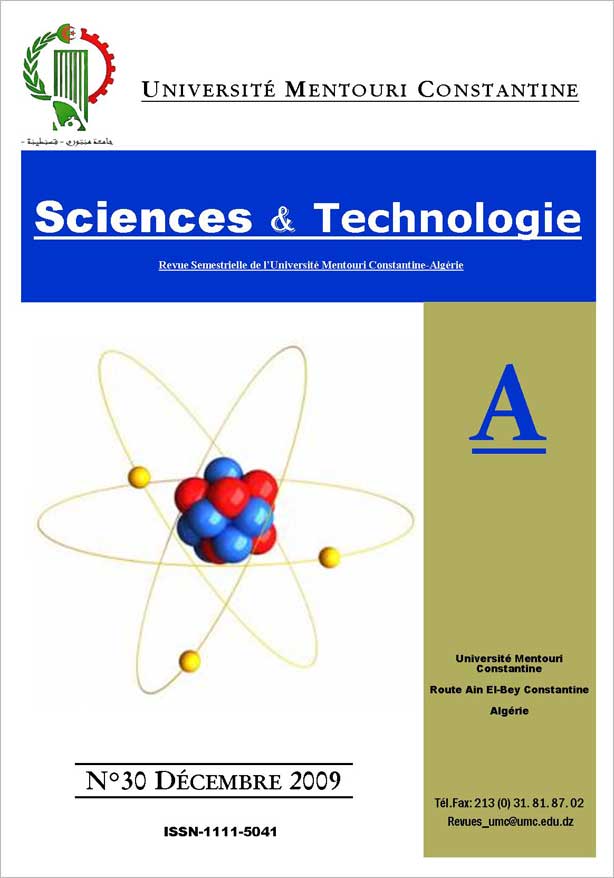INFLUENCE OF THE SELF-BIAS VOLTAGE ON THE MICROSTRUCTURE OF HYDROGENATED AMORPHOUS CARBON FILMS ELABORATED BY RF-PECVD
Keywords:
PECVD, a-C, H, FTIR, Raman spectroscopy, graphitizationAbstract
Hydrogenated amorphous carbon films (a-C:H) were deposited at room temperature in an rf-PECVD reactor using different DC self-biases (150 – 240 V). The microstructure of the films was then analysed by infrared transmission spectroscopy and Raman spectroscopy. The IR results show that hydrogen is bonded to both sp3C and sp2C atoms in all samples: more than 60% of bonded H is in sp3CHx groups (x = 2, 3) while only 13 to 17% is in sp2CH species in graphitic clusters (probably aromatic rings). The influence of self-bias voltage Vb on the microstructure of the a-C:Hfilms is also demonstrated by Raman scattering analysis. Indeed, a linear relationship between the ratio of the integrated intensity of the D peak over that of the G one (ID/IG) and the G peak FWHM (G) was found for films prepared at relatively high Vb values (Vb higher than -150 V). As the DC bias Vb increases, the ratio ID/IG increases while G becomes narrower. Also G is strongly affected by the graphitization of the material and hence the presence of graphitic clusters. The observed values of G (166 – 178 cm-1) and ID/IG (≤ 1) for our films suggest that the graphitic clusters sizes are less than 10 Å. Moreover, the relative low hydrogen content of these films, as shown by infrared transmission spectra, in addition to the former characteristics and to the values of band gap width, indicate that
our a-C:H films seem to exhibit properties which lie between those of polymeric and DLC films.
Downloads
References
A.C. Ferrari, and J. Robertson, “Interpretation of Raman spectra of disordered and amorphous carbon”, Phys. Rev. B 61, (2000), pp. 14095 - 14106
R. Haerle, E. Riedo, A. Pasquarello, and A. Baldereschi, “sp2/sp3 hybridization ratio in amorphous carbon from C 1s core-level shifts: X-ray photoelectron spectroscopy and first-principle calculation”, Phys. Rev.
B 65, (2001), pp. 045101 - 045109
B. Bushan, “Chemical, mechanical and tribological characterization of ultra-thin and hard amorphous carbon coatings as thin as 3.5 nm: recent developments”, Diamond Relat. Mater. 8, (1999), pp. 1985 - 2015
C. Casiraghi, F. Piazza, A.C. Ferrari, D. Grambole, and J. Robertson, “Bonding in hydrogenated diamond-like carbon by Raman spectroscopy”, Diamond Relat. Mater. 14, (2005), pp. 1098 - 1102
N.A. Morrison, S.E. Rodil, A.C. Ferrari, J. Robertson, and W.I. Milne, “High rate deposition of ta-C:H using an electron cyclotron wave resonance plasma source”, Thin Solid Films 337, (1999), pp. 71 - 73
B. Racine, M. Benlahsen, K. Zellama, R. Bouzerar, J.P. Kleider, and H.J. von Bardeleben, “Electronic properties of hydrogenated amorphous carbon films deposited usin ECR-RF plasma method”, Diamond Relat.
Mat. 10, (2001), pp. 200 - 206
M.-L. Theye, V. Paret, and A. Sadki, “Relations between the deposition conditions, the microstructure and the defects in PECVD hydrogenated amorphous carbon films; influence of the electronic density of states”,
Diamond Relat. Mat. 10, (2001), pp. 182 - 190
M.A. Tamor, and W.C. Vassell, “Raman ‘‘fingerprinting’’ of amorphous carbon films”, J. Appl. Phys. 76, (1994), pp. 3823 - 3830
S. Piscanec, M. Lazzeri, F. Mauri, A.C. Ferrari, and J. Robertson, “Kohn anomalies and electron – phonon interactions in graphite”, Phys. Rev. Lett. 93, (2004), pp. 185503/1 – 185503/4
Y. Bounouh, K. Zellama, A. Zeinert, M. Benlahsen, M. Clin, and M.-L. Theye, “Modes of hydrogen incorporation in hydrogenated amorphous carbon (a-C:H); modifications with annealing temperature”, J. Phys. III France 7, (1997), pp. 2159 - 2164
D. Beeman, J. Silverman, R. Lynds, and M.R. Anderson, “Modeling studies of amorphous carbon”, Phys. Rev. B 30, (1984), pp. 870 - 875
J. Schwan, S. Ulrich, V. Batori, H. Errhardt, and S.R.P. Silva, “Raman spectroscopy on amorphous carbon”, J. Appl. Phys. 80, (1996), pp. 440 - 447
J. Filik, P.W. May, S.R.J. Pearce, R.K. Wild, and K.R. Hallam, “XPS and laser Raman analysis of hydrogenated amorphous carbon films”, Diamond Relat. Mat. 12, (2003), pp. 974 - 978
J. Robertson, “Diamond-like amorphous carbon”, Mater. Sci. Eng. R 37, (2002), pp. 129 - 281







